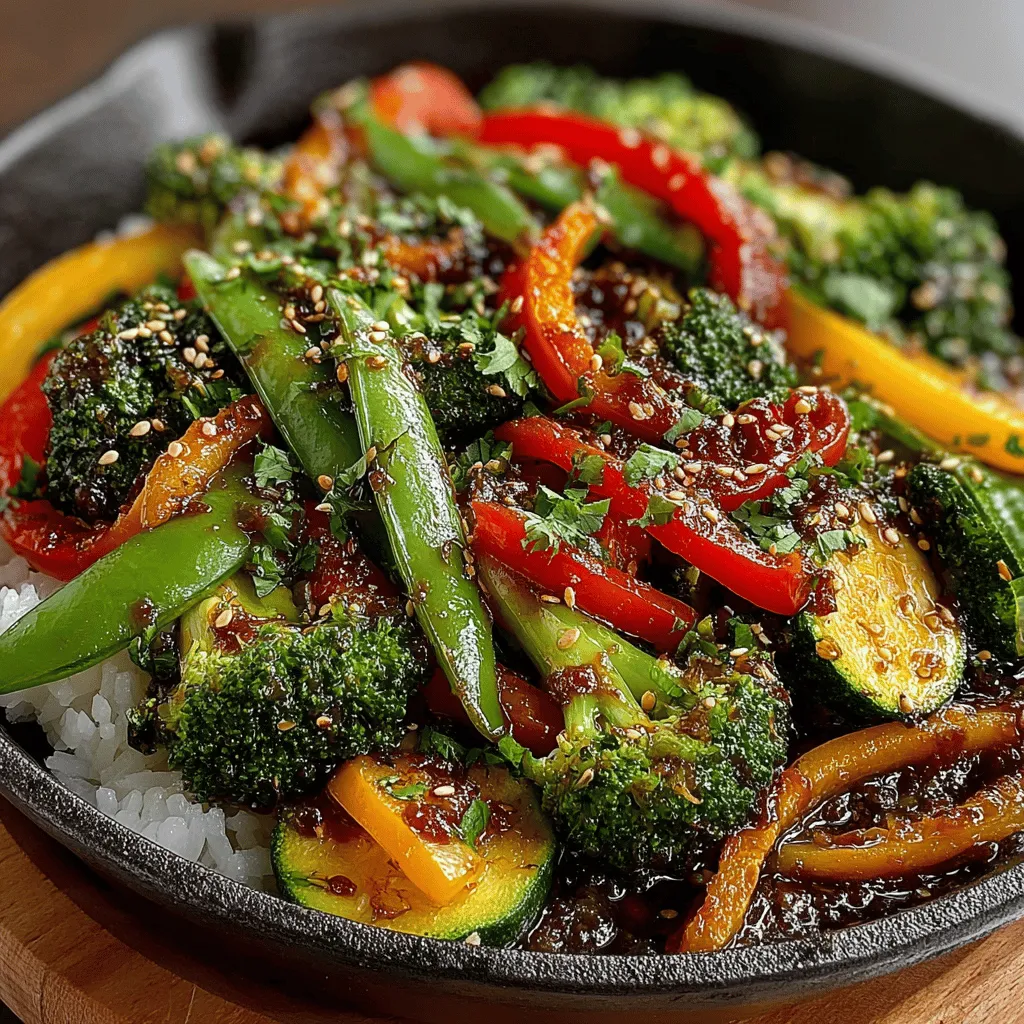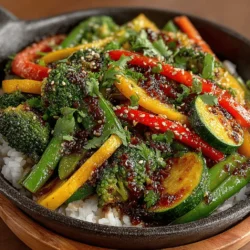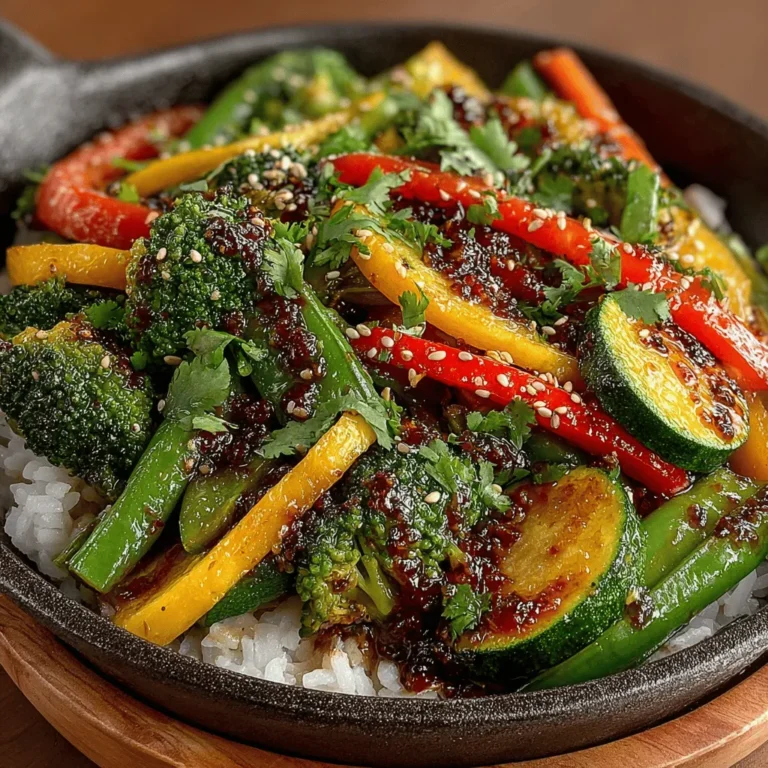Stir-fry is a cooking technique that allows for a quick, healthy meal preparation that retains the vibrant flavors and nutrients of fresh vegetables. This Quick & Colorful Veggie Stir-Fry is not only visually appealing but also packed with essential vitamins and minerals. Incorporating a variety of colorful vegetables into your meals can enhance your overall diet, making it more balanced and nutritious. The emphasis on a plant-based diet promotes health and wellness, making this recipe an excellent choice for anyone looking to improve their eating habits.
Ingredients
– 1 cup broccoli florets
– 1 red bell pepper, sliced
– 1 yellow bell pepper, sliced
– 1 medium carrot, julienned
– 1 cup snap peas
– 1 small zucchini, sliced
– 2 tablespoons vegetable oil
– 3 cloves garlic, minced
– 1 tablespoon fresh ginger, minced
– 3 tablespoons soy sauce (or tamari for gluten-free)
– 1 tablespoon sesame oil
– 1 teaspoon cornstarch (optional, for thickening)
– Salt and pepper to taste
– Sesame seeds for garnish (optional)
– Cooked rice or noodles for serving
Instructions
1. Begin by washing and preparing all the vegetables. Chop, slice, and julienne them as indicated in the ingredients list.
2. In a small bowl, whisk together the soy sauce, sesame oil, and cornstarch (if using). Set this sauce mixture aside.
3. Heat the vegetable oil in a large skillet or wok over medium-high heat.
4. Add the minced garlic and ginger to the skillet, sautéing for about 30 seconds until fragrant.
5. Add the broccoli, bell peppers, carrot, and snap peas to the skillet. Stir-fry for approximately 3-4 minutes until the vegetables are tender-crisp.
6. Incorporate the zucchini and continue to stir-fry for an additional 2 minutes.
7. Pour the prepared sauce over the vegetables, mixing well to ensure an even coating. Cook for another 1-2 minutes until the sauce has thickened slightly.
8. Season with salt and pepper to taste.
9. Serve the stir-fry over cooked rice or noodles and garnish with sesame seeds if desired.
Understanding the Ingredients
This Quick & Colorful Veggie Stir-Fry highlights a selection of nutrient-dense ingredients that contribute to a healthy diet. Each vegetable in this recipe offers unique nutritional benefits. For instance, broccoli is high in vitamins C and K, while bell peppers are rich in antioxidants. Carrots not only provide beta-carotene but also add a sweet crunch, and snap peas are an excellent source of fiber.
Using fresh, seasonal vegetables enhances both the flavor and the health benefits of the dish. Seasonal produce tends to be more flavorful and nutritious, making it a better choice for your stir-fry. Additionally, this recipe is versatile; you can easily substitute vegetables based on personal preference or dietary restrictions. For example, if you need a low-carb option, consider replacing carrots and peas with cauliflower and spinach.
Preparation Steps for Success
Proper preparation of your vegetables is crucial for a successful stir-fry. Begin by washing all produce thoroughly to remove any dirt or pesticides. Organizing your ingredients before cooking will streamline the process and ensure that you have everything at hand when you need it.
1. Wash and dry all vegetables.
2. Chop, slice, and julienne according to the ingredient list.
3. Arrange your prepared vegetables in separate bowls for easy access during cooking.
4. Select high-quality, fresh produce to maximize flavor and nutritional value, ensuring a delightful eating experience.
Crafting the Perfect Sauce
The sauce plays a vital role in stir-frying, infusing the vegetables with flavor and moisture. In this recipe, the combination of soy sauce, sesame oil, and optional cornstarch creates a deliciously savory glaze. Soy sauce provides umami richness, while sesame oil adds a nutty depth. If you’re looking for alternatives, low-sodium soy sauce or gluten-free tamari can be used to accommodate various dietary needs.
For those who enjoy experimenting with flavors, consider adding a splash of rice vinegar for acidity or a hint of chili paste for heat. The possibilities for customization are endless, allowing you to tailor the dish to your taste preferences.
The Cooking Process: A Step-by-Step Guide
The cooking method for stir-frying is essential to achieving the desired texture and flavor of your vegetables. High heat and quick cooking times are key factors in this technique.
1. Preheat your skillet or wok to ensure it is hot enough to sear the vegetables effectively.
2. Cook vegetables in small batches if necessary; overcrowding the pan can lead to steaming rather than stir-frying.
3. Maintain a constant motion by stirring frequently to ensure even cooking and prevent burning.
By following these steps and tips, you will create a Quick & Colorful Veggie Stir-Fry that is not only delicious but also packed with nutrients, making it an excellent addition to your meal rotation.

Detailed Instructions for Sautéing Aromatics for Maximum Flavor
To elevate your veggie stir-fry, mastering the art of sautéing aromatics is essential. Start by selecting a combination of garlic, ginger, and onions. Heat your oil in a large skillet or wok over medium-high heat until it shimmers. Add minced garlic and ginger first, stirring them for about 30 seconds until fragrant. Follow with sliced onions, allowing them to become translucent and sweeten, typically taking around 3-5 minutes. This base will infuse the entire dish with flavor, making each bite more aromatic and delicious.
Tips for Achieving the Perfect Tender-Crisp Texture in Vegetables
Achieving that ideal tender-crisp texture is crucial for a successful stir-fry. Here are some tips:
1. Cut Uniformly: Slice vegetables into similar sizes to ensure even cooking. This helps them cook at the same rate, preventing some from becoming mushy while others remain raw.
2. High Heat is Key: Stir-frying requires high heat to cook quickly. This technique seals in moisture while providing a slight char that enhances flavor.
3. Cook in Batches: If your skillet or wok is too crowded, the vegetables will steam instead of sautéing. Cook in smaller batches to maintain high heat throughout the process.
4. Add in Stages: Start with heartier vegetables like carrots and broccoli, which take longer to cook, then add quicker-cooking ones like bell peppers and snap peas later.
Importance of Seasoning During Cooking for Depth of Flavor
Proper seasoning is vital at every step of the cooking process. Begin by seasoning the oil with salt as it heats to enhance the flavor of the aromatics. Once the vegetables are added, taste and adjust the seasoning as you go. Consider incorporating soy sauce, oyster sauce, or a splash of sesame oil for added depth. Fresh herbs and spices can also be sprinkled in at the end for a burst of freshness. Remember, balance is key—don’t overpower the natural flavors of the vegetables.
Serving Suggestions
Ideas for Pairing the Stir-Fry with Rice or Noodles
A veggie stir-fry pairs wonderfully with a variety of starches. For a classic combination, serve it over steamed jasmine or basmati rice. Alternatively, you can use whole grain rice or quinoa for a healthier option. Noodles, such as soba or rice noodles, provide a delightful variation. Toss the noodles into the stir-fry during the last few minutes of cooking for a cohesive dish.
Suggestions for Garnishes to Enhance Presentation and Flavor
To elevate your stir-fry, consider garnishing with fresh herbs like cilantro or green onions. Toasted sesame seeds or chopped nuts can add a crunchy texture, while a drizzle of lime juice or chili oil can enhance the dish’s complexity and brightness. These simple additions not only boost the flavor profile but also contribute to an appealing presentation.
Nutritional Balance: How to Create a Complete Meal with the Stir-Fry
To ensure your stir-fry is a complete meal, aim for a balance of macronutrients. Combine your colorful vegetables with a source of protein such as tofu, tempeh, chicken, or shrimp, according to your dietary preferences. Including a healthy fat source, like avocado or a sprinkle of sesame oil, can also enhance satiety. Lastly, incorporating a side of fruit or a light salad can add freshness and additional nutrients.
Health Benefits of a Veggie Stir-Fry
Discussion on the Health Benefits of a Vegetable-Rich Diet
A vegetable-rich diet is linked to numerous health benefits, including reduced risks of chronic diseases such as heart disease, diabetes, and obesity. Vegetables are packed with vitamins, minerals, and fiber, contributing to overall health and wellness.
Insights into the Impact of Colorful Vegetables on Well-Being
Colorful vegetables are not only visually appealing but also signify a range of nutrients. For example, orange and yellow vegetables are high in vitamin C, while leafy greens are rich in iron and calcium. Eating a variety of colors ensures a broad spectrum of nutrients, promoting optimal health.
Overview of the Stir-Fry as a Low-Calorie, Nutrient-Dense Meal Option
Stir-fries can be low-calorie while still being nutrient-dense. The quick cooking method preserves the vitamins and minerals found in vegetables, making them a smart choice for weight management and overall health. By incorporating a variety of veggies, lean proteins, and healthy fats, you create a fulfilling meal without excessive calories.
Cultural Significance of Stir-Frying
Brief History of Stir-Frying in Asian Cuisine
Stir-frying has its roots in Asian cuisine, particularly in China, where it originated over 2,000 years ago. The technique was developed out of necessity for quick cooking using minimal fuel, making it an efficient method for preparing meals.
The Evolution of Stir-Frying as a Global Cooking Technique
As cultures have intertwined, stir-frying has evolved into a globally recognized cooking technique. It has been adapted to suit various ingredients and flavors, integrating local spices and culinary traditions while maintaining its core principles of high heat and quick cooking.
How Stir-Frying Can Be Adapted to Different Culinary Traditions
Stir-frying is versatile and can easily accommodate different cuisines. From Thai to Italian, you can experiment with various sauces, spices, and ingredients to create unique dishes. This adaptability makes stir-frying an excellent choice for home cooks seeking to explore global flavors.
Conclusion
Making a Quick & Colorful Veggie Stir-Fry offers numerous benefits, from health advantages to culinary creativity. The process encourages you to embrace fresh ingredients and personal variations, allowing for a unique dish every time. As you explore the art of stir-frying, remember that preparing vibrant, healthy meals is not just about nutrition; it’s about enjoying the cooking experience and delighting in the flavors of wholesome food.


